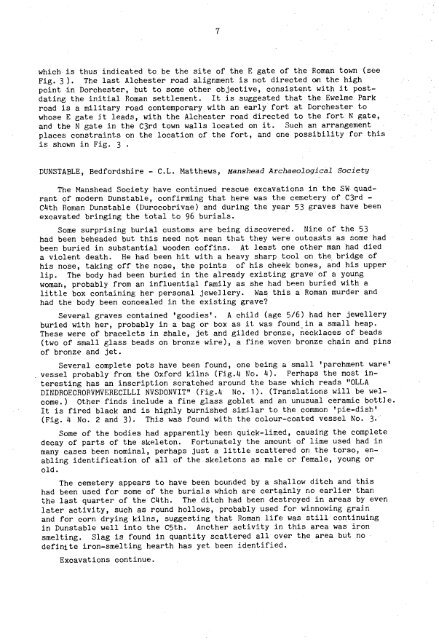Untitled - Council for British Archaeology
Untitled - Council for British Archaeology
Untitled - Council for British Archaeology
- No tags were found...
You also want an ePaper? Increase the reach of your titles
YUMPU automatically turns print PDFs into web optimized ePapers that Google loves.
7which is thus indicated to be the site of the E gate of the Roman town (seeFig. 3). The last Alchester road alignment is not directed on the highpoint in Dorchester, but to some other objective, consistent with it postdatingthe initial Roman settlement. It is suggested that the Ewelme Parkroad is a military road contemporary with an early <strong>for</strong>t at Dorchester towhose E gate it leads, with the Alchester road directed to the <strong>for</strong>t N gate,and the N gate in the C3rd town walls located on it. Such an arrangementplaces constraints on the location of the <strong>for</strong>t, and one possibility <strong>for</strong> thisis shown in Fig. 3 .DUNSTABLE, Bed<strong>for</strong>dshire - C.L. Matthews, manshead Archaeological SocietyThe Manshead Society have continued rescue excavations in the SW. quadrantof modern Dunstable, confirMing that here was the cemetery of C3rd -C4th Roman Dunstable (Durocobrivae) and during the year 53 graves have beenexcavated bringing the total to 96 burials.Some surprising burial customs are being discovered. Nine of the 53had been beheaded but this need not mean that they were outcasts as some hadbeen buried in substantial wooden coffins. At least one other man had dieda violent death. He had been hit with a heavy sharp tool on the bridge ofhis nose, taking off the nose, the points of his cheek bones, and his upperlip. The body had been buried in the already existing grave'of a youngwoman, probably from an influential family as she had been buried with alittle box containing her personal jewellery. Was this a Roman murder andhad the body been concealed in the existing grave?Several graves contained 'goodies'. A child (age /6) had her jewelleryburied with her, probably in a bag or box as it was found_in a small heap.These were of bracelets in shale, jet and gilded bronze, necklaces of beads(two of small glass beads on bronze wire), a fine woven bronze chain and pins.of bronze and jet.Several complete pots have been found, one being a small 'parchment ware'vessel probably from the Ox<strong>for</strong>d kilns (Fig.4 No. 4). Perhaps the most interestinghas an inscription scratched around the base which reads "OLLADINDROECRORVMVERECILLI NVSDONVIT" (Fig.4 No. 1). (Translations will be welcome.)Other finds include a fine glass goblet and an unusual ceramic bottle.It is fired black and is highly burnished similar to the common 'pie-dish'(Fig. 4 No. 2 and 3). This was found with the colour-coated vessel No. 3;Some of the bodies had apparently been quick-limed, causing the completedecay of parts of the skeleton. Fortunately the amount of lime used had inmany cases been nominal, perhaps just a little scattered on the torso, enablingidentification of all of the skeletons as male or female, young orold.The cemetery appears to have been bounded by a shallow ditch and thishad been used <strong>for</strong> some of the burials which are certainly no earlier thanthe last quarter of the C4th. The ditch had been destroyed in areas by evenlater activity, such as round hollows, probably used <strong>for</strong> winnowing grainand <strong>for</strong> corn drying kilns, suggesting that Roman life was still continuingin Dunstable well into the C5th. Another activity in this area was ironsmelting. Slag is found in quantity scattered all over the area but nodefinite iron-smelting hearth has yet been identified.Excavations continue.
















